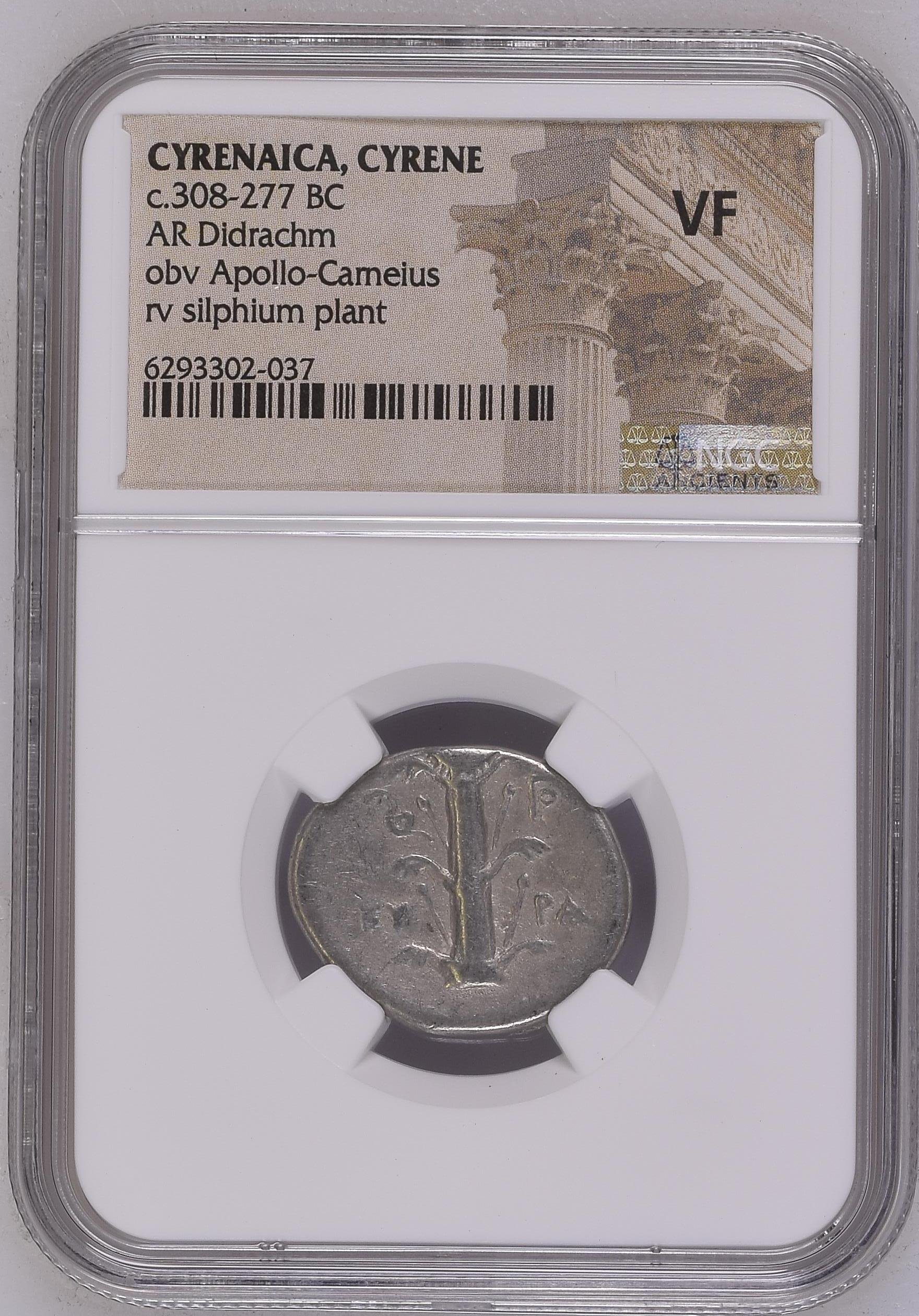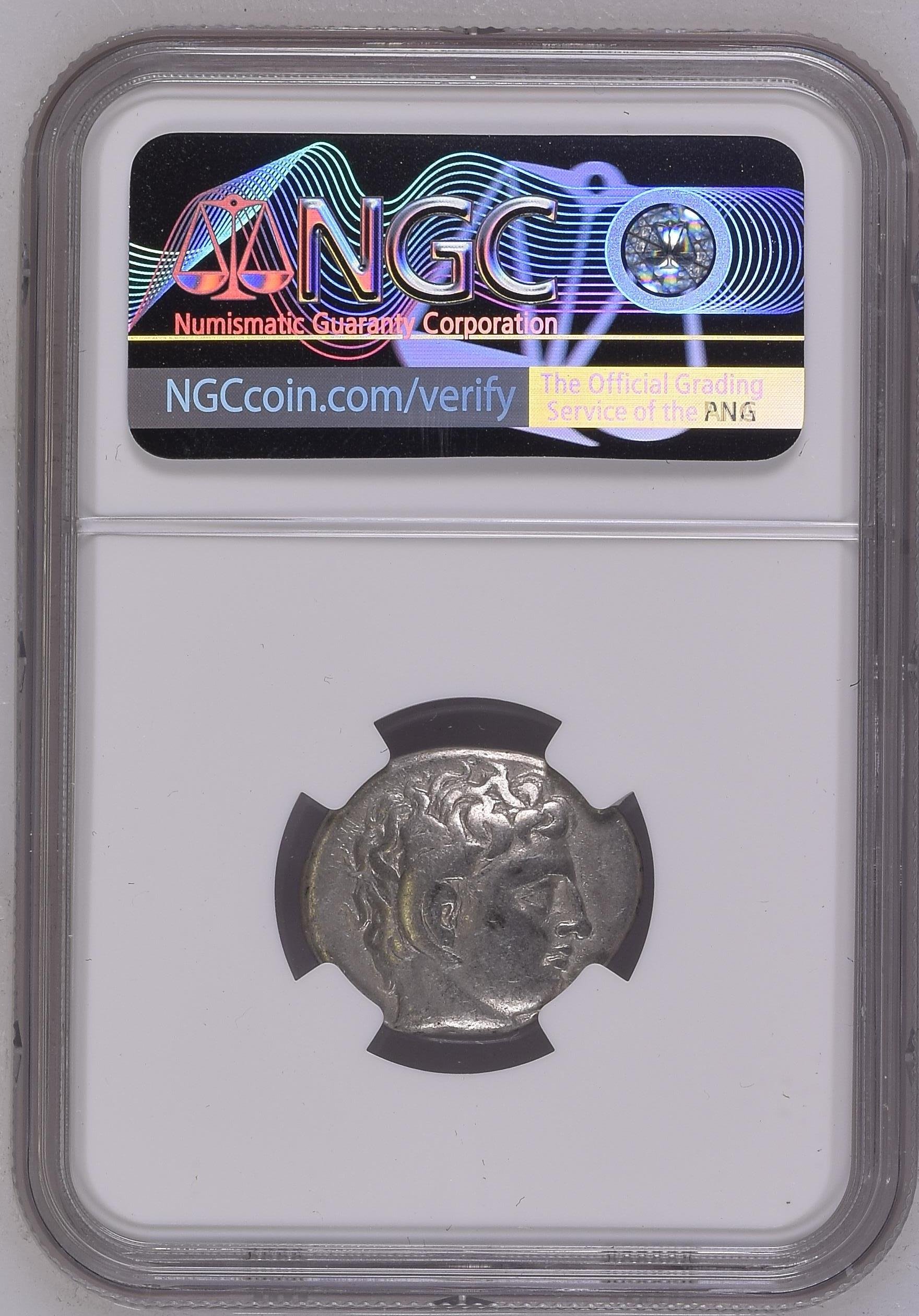 Image 1 of 2
Image 1 of 2

 Image 2 of 2
Image 2 of 2

Silver Didrachm from Cyrene (about 2,300 years ago)
This is another example of a silver didrachm from Cyrene, an important Greek colony in North Africa (modern-day Libya). Minted during the period 308-277 BCE when the region was under Ptolemaic influence, this coin reflects the artistry and economic importance of this wealthy Mediterranean trading center. Like other coins from this mint, it combines local religious symbolism with representations of the city's economic foundation.
Coin Description:
Front side: The obverse shows Apollo-Carneius with his distinctive curled hair and wreath. This depiction honors the city's patron deity in his special local form as Apollo-Carneius.
Back side: The reverse displays the iconic silphium plant with its characteristic stem, leaves, and seed pods. This plant was the symbol of Cyrene and source of its tremendous wealth.
Technical Details:
Silver composition (AR)
Didrachm denomination (a substantial coin worth two drachms)
Weight: Approximately 7-8 grams
Size: Approximately 20-22mm in diameter
NGC Grade: VF (Very Fine) - showing clear details with signs of circulation
Date of minting: 308-277 BCE (Early Hellenistic Period)
Historical Significance: This didrachm was struck during a time of significant transition in the Mediterranean world. Following Alexander the Great's death, Cyrene came under the influence of the Ptolemaic dynasty based in Egypt. The city had been founded centuries earlier by Greek colonists from Thera (modern Santorini) and became extraordinarily wealthy due to its monopoly on the silphium trade. This valuable plant, now extinct, was used throughout the ancient Mediterranean for cooking, medicine, and birth control, and was worth its weight in silver. The appearance of silphium on the city's coinage emphasized its economic importance to the region. A didrachm like this would have had significant purchasing power in daily transactions across the Mediterranean trading networks.
This is another example of a silver didrachm from Cyrene, an important Greek colony in North Africa (modern-day Libya). Minted during the period 308-277 BCE when the region was under Ptolemaic influence, this coin reflects the artistry and economic importance of this wealthy Mediterranean trading center. Like other coins from this mint, it combines local religious symbolism with representations of the city's economic foundation.
Coin Description:
Front side: The obverse shows Apollo-Carneius with his distinctive curled hair and wreath. This depiction honors the city's patron deity in his special local form as Apollo-Carneius.
Back side: The reverse displays the iconic silphium plant with its characteristic stem, leaves, and seed pods. This plant was the symbol of Cyrene and source of its tremendous wealth.
Technical Details:
Silver composition (AR)
Didrachm denomination (a substantial coin worth two drachms)
Weight: Approximately 7-8 grams
Size: Approximately 20-22mm in diameter
NGC Grade: VF (Very Fine) - showing clear details with signs of circulation
Date of minting: 308-277 BCE (Early Hellenistic Period)
Historical Significance: This didrachm was struck during a time of significant transition in the Mediterranean world. Following Alexander the Great's death, Cyrene came under the influence of the Ptolemaic dynasty based in Egypt. The city had been founded centuries earlier by Greek colonists from Thera (modern Santorini) and became extraordinarily wealthy due to its monopoly on the silphium trade. This valuable plant, now extinct, was used throughout the ancient Mediterranean for cooking, medicine, and birth control, and was worth its weight in silver. The appearance of silphium on the city's coinage emphasized its economic importance to the region. A didrachm like this would have had significant purchasing power in daily transactions across the Mediterranean trading networks.
This is another example of a silver didrachm from Cyrene, an important Greek colony in North Africa (modern-day Libya). Minted during the period 308-277 BCE when the region was under Ptolemaic influence, this coin reflects the artistry and economic importance of this wealthy Mediterranean trading center. Like other coins from this mint, it combines local religious symbolism with representations of the city's economic foundation.
Coin Description:
Front side: The obverse shows Apollo-Carneius with his distinctive curled hair and wreath. This depiction honors the city's patron deity in his special local form as Apollo-Carneius.
Back side: The reverse displays the iconic silphium plant with its characteristic stem, leaves, and seed pods. This plant was the symbol of Cyrene and source of its tremendous wealth.
Technical Details:
Silver composition (AR)
Didrachm denomination (a substantial coin worth two drachms)
Weight: Approximately 7-8 grams
Size: Approximately 20-22mm in diameter
NGC Grade: VF (Very Fine) - showing clear details with signs of circulation
Date of minting: 308-277 BCE (Early Hellenistic Period)
Historical Significance: This didrachm was struck during a time of significant transition in the Mediterranean world. Following Alexander the Great's death, Cyrene came under the influence of the Ptolemaic dynasty based in Egypt. The city had been founded centuries earlier by Greek colonists from Thera (modern Santorini) and became extraordinarily wealthy due to its monopoly on the silphium trade. This valuable plant, now extinct, was used throughout the ancient Mediterranean for cooking, medicine, and birth control, and was worth its weight in silver. The appearance of silphium on the city's coinage emphasized its economic importance to the region. A didrachm like this would have had significant purchasing power in daily transactions across the Mediterranean trading networks.
Silphium is a genus of North American plants in the tribe Heliantheae within the family Asteraceae.[1][2]
Members of the genus, commonly known as rosinweeds, are herbaceous perennial plants growing to 0.2 m (8 in) to more than 2.5 m (8 ft 2 in) tall, with yellow (rarely white) flowerheads that resemble sunflowers. In the rosinweeds, the ray florets in the head are female and the disc florets are male;[3] this differs from sunflowers, where ray florets are sterile and disc florets are perfect, capable of producing both pollen and seeds.[4]
You Might Also Like











